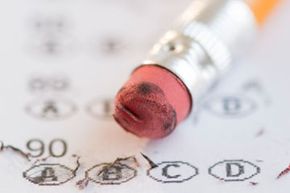You probably don't think about pencils and erasers much in today's world of digital and mobile access to everything; while it's undeniable that the No. 2 pencil and the SAT have a long history together, pencils don't really come up much outside of standardized testing anymore. But despite our devotion to our devices, Americans still use more than 2 billion pencils every year [source: Lunsford].
Contrary to popular belief, pencils aren't really made with lead, and haven't been since Roman scribes wrote on papyrus -- that's a common pencil myth. So if you chew on your pencils, rest assured you won't become ill from lead poisoning (although that's not a free pass to snack on a No. 2). Today's pencils are made with graphite, water and clay (which is used as a binder), and pencil lead has been made this way since Nicolas-Jacques Conté invented the mixture in 1795 [source: Ritter]. They weren't topped with an eraser tip, though, until about a century later. And it's this companion to the pencil, the eraser, that we're interested in here.
Advertisement
Erasers eradicate pencil markings by lifting graphite from the paper you've written on. As you write, particles of graphite from your pencil mingle with and cling to particles in the fiber of the paper. Here's the science: Modern erasers are almost always made from petroleum-based synthetic rubber compounds, typically polyvinyl chloride (they're no longer made from natural latex rubber, which is an allergen for some people). Because the particles in the polymer that make up an eraser are stickier than paper, those graphite particles get stuck to the eraser instead. Some erasers are stickier than others and absorb graphite particles more easily, giving you a cleaner, less-abrasive result.
Believe it or not, one of the very first erasers used was moist bread. Let's talk about how far erasers have come since the days of day-old bread, next.
Advertisement



